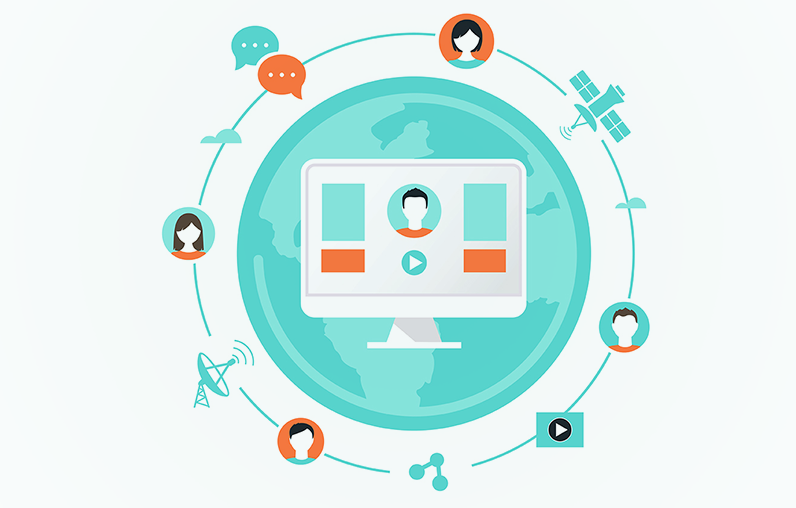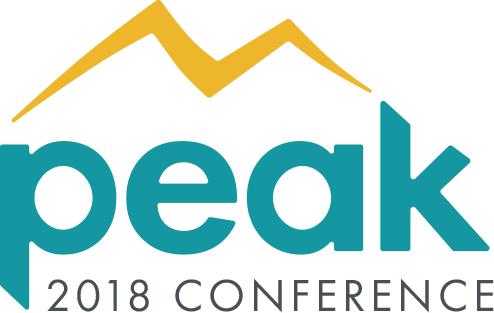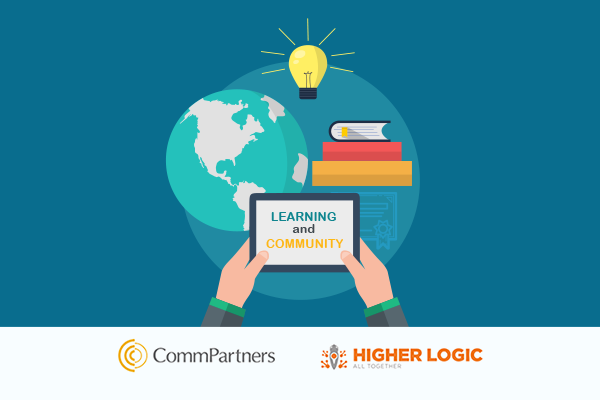
by Aubrey Mellos | Mar 5, 2018 | Blog
Guest blog by Bobby Kaighn, Higher Logic
Online learning is valuable, convenient, and scalable, which makes it an ideal benefit for associations. In the last few years, online learning has also proven to be very popular for members who want to advance their careers.
But many online learning programs aren’t as effective as they could be. Most courses are meant for individuals, which can feel isolating to some members, while other learners may find it difficult to apply online concepts in their daily lives.
Online learning communities can help.
By pairing your online learning programs with an online community, you can improve the member experience and help information stick, which will make your programs more effective. It could even boost enrollment.
Here are four ways community can improve online learning.
Four Ways An Online Learning Community Can Improve Your eLearning Program
1. Community Discussions Keep Learners Engaged
Coursework, no matter how interesting, can be tiring. An online learning community adds an interactive element to elearning courses, including peer discussions, file libraries, blogs and emails.
Learners can use these tools to connect with their peers and start conversations about course topics. They can also ask questions and share their thoughts on how course material relates to their lives. All this interaction helps learners engage with your courses and can make the material in them more meaningful.
2. Peer Support Helps Learners Complete Courses
Unlike traditional education, online learning doesn’t have a built-in support system. You can’t walk up to a professor after a lecture to ask a question or form a study group with friends. In online learning, if someone gets stuck on a challenging concept or loses motivation to complete the program, there may not be anyone around to help.
With an online learning community, you give learners that network of peers. You give them a space where they can connect with peers who are also working through the same course and can help them through difficult material. Participants can ask for help publicly through discussion forums or use private email if they don’t want to open their concern up to the group. Their peers can also help motivate them to finish through conversations or by sharing helpful material, just like they would have in a traditional learning environment.
3. Community Mentoring Programs Help Learners Apply New Skills
Many associations use online learning programs to help members with professional development. With an online community, you can add practical experience to online concepts through a mentoring program.
Learners can either sign up for a mentor while they’re taking the course or after completing the program. Their mentor will then help them apply course concepts in their daily lives, giving them advice and tips based on experience.
By using a community mentoring program to help learners apply course concepts, you make it more likely that they’ll remember and use what they learned. That, in turn, translates to members getting more value from your programs.
4. Community Networking Extends Engagement After Learners Finish Courses
Traditional education uses networking tools like class reunions and alumni groups to build deeper, long-term connections between students and organizations. Often, those connections result in generous financial or advocacy commitments to schools.
Your association can use an online learning community for similar benefits. Build a community for your learning program alumni so they can continue networking and stay involved with your association after their courses are over. They can use their new connections to provide continued support, pursue job opportunities, and more. This long-term networking will also help keep your association and its programs top of mind, which could lead to future referrals as alumni find new people who could benefit from your programs.
Use Community to Improve Your Online Learning Programs and the eLearning Experience
Online communities provide the social element that’s often missing with online learning programs. They allow learners to connect with peers, share their thoughts, and get the support they need for a successful educational experience.
And, by improving your online learning programs, you also increase the value members get from your association, making it more likely they’ll stick with you and refer their friends and family.
Some associations choose to invest in a learning management system to create an online community and promote collaboration between learners. If you would like more information on how to create quality educational experiences that engage and inspire the learner, give us a call at (800) 274-9390 or fill out our online contact form to get in touch with someone.

by Rich Finstein | Nov 13, 2017 | Blog
At the 2017 Higher Logic Super Forum, I along with an association colleague, facilitated a session on the virtues of developing an integrated approach for bringing together online community engagement and an LMS in a single offering. During the session, we discussed how associations typically have these areas configured as unique components. In reality, both provide opportunities for learning. Since an online community engagement strategy is usually focused on facilitating peer collaboration, and the learning management system (LMS) provides expert content, it’s natural they come together to support the stakeholder experience in a synergistic way.
A key connector in this relationship are live online events and webinars. Traditionally, live events and webinars have been positioned on their own through a registration and authentication page provided by the webinar vendor or a separate catalog of programs. A better, more engaging approach is to promote and provide access to these events within a private community.
Here are 5 considerations for using live, online events and webcasts to increase the impact of your online community engagement strategy:
- Registration will feel like a continuum of existing collaboration. Participants who have already been invested in the topic can now be encouraged, in an intuitive way, to take the step to register and participate in online discussions.
- Participation from new and non-engaged members is encouraged with an integrated approach. Live, online events and webinars are tangible ways to draw participants to specific areas of your Web presence. Offering them through a dedicated part of your LMS gives users a reason to create a profile and begin to participate in other social learning and online community engagement opportunities.
- Leverage interaction before and after an online event or webcast. Participants should be able to see who is attending, exchange ideas, and engage the presenters before the event. Afterward, users can continue any conversations that may have been cut short (which happens often!) during an hour program.
- Integrate results from live event and webinar attendance with other participation metrics, providing a complete picture of online community engagement. Host organizations will appreciate having a central repository to evaluate participation outcomes.
- Award badges or ribbons for participation or achievement from webinars in the same area where recognition is provided for other activities. Providing recognition will further encourage participation in future live, online events.
We see webinars and live events becoming much more collaborative and transparent. Bringing them into your online community is a natural way to build participation and provide synergy with your other educational objectives.
If you have interest in learning more about integrating events and webinars with your community contact us online, or email Meghan Gowen at mgowen@commpartners.com.

by Aubrey Mellos | Nov 1, 2017 | News
Columbia, MD – November 1, 2017. CommPartners, a leading provider of Learning Management Software, webinar, webcast, and livestream solutions announced details for Peak 2018 Conference. The event will take place March 15-16, 2018 in Washington, D.C.
Peak is a conference designed to inspire, educate, and train association professionals in a wide range of e-learning topics. The event will feature two keynote sessions, eight breakout sessions, deep-dive Elevate LMS trainings, peer knowledge exchanges, and more. Topics include Social Learning, Building a Dynamic LMS, Credentialing, Course Design, and e-Learning Trends. A complete agenda can be found at www.commpartners.com/Peak.
“We are excited to host our first conference where association peers can come together and not only receive extensive training on Elevate Learning Management System and our other services, but to also learn from peers who share similar challenges.” Richard Finstein, CEO, CommPartners
Learning opportunities and trainings will provide value to all professionals who have a key role in their organizations education and professional development strategy. Attendees will be eligible for up to 4 CAE credits and will also have the opportunity to connect socially with peers, partners, and industry leaders during a happy hour reception.
“It is our goal that attendees leave Peak 2018 with clear direction on how to revolutionize their online learning programs and to arm them with the tools to help them get there”, explains Finstein.
Peak 2018 – CommPartners’ First Education & User Conference
March 15-16, 2018
District Architecture Center | Washington D.C.
www.commpartners.com/peak
About CommPartners
CommPartners is a leading provider of online education and event solutions. At the core of the company’s solutions is our Elevate Learning Management System. Elevate is the only LMS with fully integrated and embedded webinar, livestream and multimedia software to support learning, how and when it occurs. The connection between live, peer-to-peer knowledge exchanges and traditional continuing education programs leads to improved learning outcomes, as well as increased participation within an organization’s education offerings. To learn more visit: www.commpartners.com

by Rich Finstein | Sep 25, 2017 | Blog
It has been almost a year since CommPartners and Higher Logic began formally collaborating with the premise that learning in its many forms is a natural extension of community engagement. This concept is not new for most of us. I remember many conversations that took place at ASAE Annual Conferences and other meetings over the years about the virtues of social learning. Everyone agreed that the notion of peer to peer, sharing of ideas should accompany and be integrated with knowledge shared by experts. After all, when we think of the best learning experiences, it’s typically a conference with our community peers. We value the sessions but a significant part of our reason for attending is the knowledge we receive from colleagues. So why is online learning experiences so segmented?
While in theory this sounded like a wise idea, the execution of social learning was slow to take hold. There are likely many reasons for this, but the lack of an online platform that truly enabled Web based social experiences was not helping to forge the way.
Last year, Higher Logic and CommPartners’ teams got together to identify how we could make community driven learning a reality. We had certain ideas and it took quite an investment of time to identify how this could work. Our first success was the creation of Higher Logic’s Online Academy courses. This training enables participants to sign up and participate in a self-paced training program (powered through our learning management system, Elevate LMS) within the community. Completion of courses is reported to Higher Logic’s activities area, giving the community member and the host organization, in this case Higher Logic, a more holistic report of engagement that was taking place.
After this initial success, our efforts turned towards helping associations realize the benefits of bridging their Learning Management System and community to offer their stakeholders an integrated experience. As the discussions evolved, one question became clear; why are we asking our participants to navigate to two separate and distinct areas of a website when both areas provide opportunities for learning? Shouldn’t the synergy between these two components be together? So we went to work and came up with a fully integrated platform both visually and programmatically.
Key elements of Higher Logic’s community and CommPartners Elevate Learning Management System now work together, prioritizing the participant experience. Twelve months later we have many organizations that have embraced this integrated approach and we have certainly learned a lot. Here are four key lessons learned from bridging these two areas:
1. In many cases organizations still need a strong, independent learning presence. In these cases we have integrated the two platforms on a micro level. Examples include pulling in community participants that are enrolled in a course or webinar or reporting learning results to the activities area in the community. These are steps that more subtly bring the two together.
2. It’s important to have staff from both your education and community teams involved. There are many variations of community driven learning that can take place. Getting initial buy-in will ensure a smooth process and better result.
3. Opportunities for social learning extend beyond typical webinars or training. A program such as a virtual conference hosted through the LMS has the power to be integrated with a conference community leveraging the engagement already in place.
4. Working together allows us to provide better guidance to our clients. It’s been extremely valuable for the Higher Logic and CommPartners teams to work closely together to bridge the knowledge gap and provide better ideas and insights to our clients.
We’re excited about continuing to bridge the gap between community and learning. If you have an interest in integrating peer to peer idea sharing with traditional learning contact a representative from either Higher Logic or CommPartners to learn more.
VIEW ON-DEMAND WEBINAR
Learning & Community: Together at Last – Register

by Aubrey Mellos | Jun 22, 2017 | Blog
FREE WEBINAR
Podcasts: Jumping Headfirst Without Fear
July 6th 1-2pm EDT
REGISTER NOW
Guest post by Doug Sandler
Think about today’s society. When people want it, they want it now. Media on-demand is hot and now more than ever it makes sense to capitalize on audio on-demand. A sharp segment of the audio on demand market is turning to podcasting to get their message out. 67 million people tune into podcasts every month* and if you are a fan of podcasts, you understand why. As a listener, you get to select your podcasts with pinpoint accuracy, the subject matter, format and style you like best. Plus, you get to choose when you listen. Your commute can turn your car into your university on wheels, or your kitchen can become your classroom while you are cooking dinner. No matter where you are, your podcasts can follow you.
Podcasting for your Association
So why should you care? As an association, this means a podcast can be utilized multi-fold. First, it can be used to provide educational content to your membership, from right within your learning management system (LMS). Spread your knowledge to your members and share best practices, industry updates and the latest news specific to your association. Additionally, podcasting is a way to reach a segment of your association that may not have the resources to make it to association gatherings. Many organizations do not have the budget to send all of their staff to conferences. With podcasting, through live recorded conference interviews, you have an opportunity to share conference content and bonus material, further engaging your membership. Furthermore, it is a great platform to diversify your learning portfolio.
Additionally, with podcasting you have an opportunity to create non-dues revenue through podcast sponsorship. Vendors and partners that regularly work with your association are looking for creative ways to reach your membership and podcasting is a premium place to meet your members and share their message. Any fees associated with podcast production can easily be offset by podcast sponsorship.
How to Get Started
Regarding production, getting set up to start a podcast is less complicated than you may think. Typically, entry to this space would consist of purchasing a high quality studio microphone, recording software and source to host your show. Like most associations, however, you might be short handed to handle the technical aspects of the show. There are many production companies for hire to handle all of the technical components of your show. The best advice would be to talk to a full-service production company so your association can develop a strategy for not only producing and editing your show, but to help you best develop a marketing plan to get your show launched and out to your membership. “Done with you” or “done for you” versions of production are available and should be investigated to get your show off and running properly.
One thing is certain, podcasting is on its way up. Now is the time to set the fear aside, get wet, and take advantage of podcasting to reach a greater percentage of your membership and develop an additional revenue stream. You will be extremely satisfied with your results.
 Doug Sandler is founder of TurnKeyPodcast.com, a full service podcast production company. He is also host of The Nice Guys on Business podcast, the #1 ranked business show on Overcast and was awarded iTunes coveted New and Noteworthy ranking when launched in 2015. His interview format show is heard in 165 countries and downloaded over 100,000 times every month.
Doug Sandler is founder of TurnKeyPodcast.com, a full service podcast production company. He is also host of The Nice Guys on Business podcast, the #1 ranked business show on Overcast and was awarded iTunes coveted New and Noteworthy ranking when launched in 2015. His interview format show is heard in 165 countries and downloaded over 100,000 times every month.
*Source: Edison Research and Triton Digital, “The Infinite Dial 2017.”






 Doug Sandler is founder of
Doug Sandler is founder of 